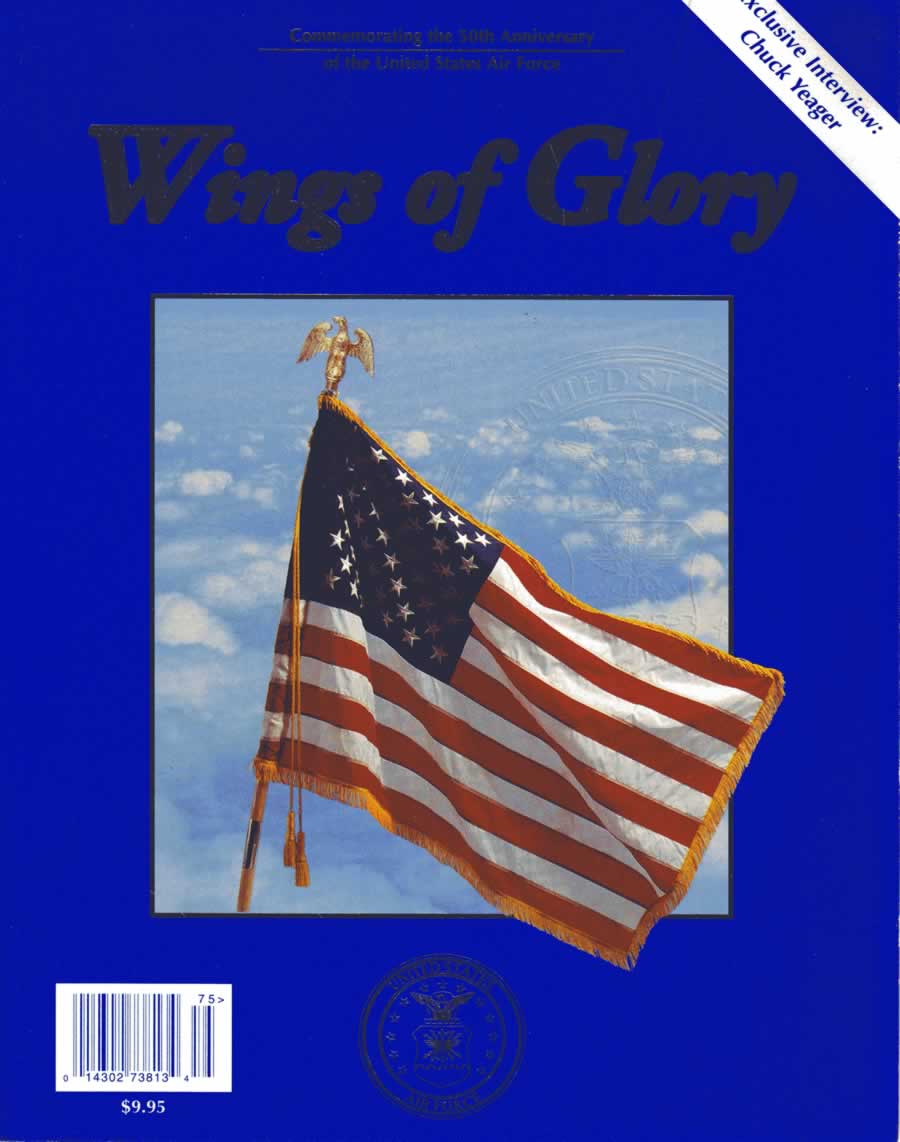The
Battle of Britain was one of the finest examples of the use of command
and control as a 'force multiplier': you didn't need a lot of airplanes,
so long as you could put just enough fighters just where they were
most needed.
But
sometimes numbers counted, and the U.S. Army Air Corps had become
the finest organization in the world at coordinating massed numbers
of
bombers, fighters, troop transports and cargo aircraft. These often
attacked the same areas at differing speeds and altitudes and after
flying in from different bases. That experience contributes today
to our ability to ferry aircraft to bases around the world, or even
to
refuel in-flight a large long-distance attack.
C3
during the Korean War took advantage of the lessons learned just
a half-decade earlier. The aircraft were a mixture of WWII holdovers
and new jet-powered
fighters. There were no massed bombing missions; small flights
of fighters
performed ground-support while B-29s bombed stationary targets.
Air Force officers slogged through the mud beside the GIs, using
radios to direct
air strikes. Radar coverage of the battlefield was spotty and short-ranged;
pilots often flew their fighters to a pre-set area and waited to
be vectored to a target of opportunity by a ground or aerial spotter.
The Vietnam war, like the war in Korea, was one of small
strikes, some down-in-the-dirt flying and some high-flying
B-52s playing the strategic-strike mission the B-29s
had done in Korea. Intelligence, and particularly weather intelligence
was much improved, thanks to some of the early satellite systems.
Some would argue that
command and control got out of hand, with President Johnson personally
picking
targets to be attacked.
One of the first tasks of the newly-created Air Force was to pose
a deterrence to the Soviet Union, and the formation of the Strategic
Air Command reflected
a new reality: for the first time, a bomber could fly from one continent
to another and deliver a payload. But if communications had been
crucial in all previous
wars, being able to communicate at extremely long range with an aircraft
carrying a nuclear weapon was essential.
But SAC also controlled America's land-based ICBMs and a missile,
once launched, could not be recalled (an argument long advanced
for retaining the manned-bomber
alternative). The Air Force developed a complex command and control system
that made it impossible for any one person to launch a missile.
All this was backed by the most comprehensive computer systems
and intelligence-gathering networks ever devised. Satellites
and high-flying aircraft looked down on the
earth. Radar nets on the ground watched for incoming missiles.This input
arrived at NORAD (North American Aerospace Defense Command) headquarters
in an underground
bunker in Cheyenne Mountain, Colorado where computers processed it and
people interpreted the results. There were occasional computer
glitches and on several
occasions the system reported impending attacks. Each time, the human commander
overrode the system.
C2 had always had to claw for every dollar in development and implementation
cost. Bombs, and new aircraft to deliver them, were tangible symbols of
the Air Force's ability to perform missions. Computer networks,
improved
radio communication,
wider "bandwidth" to process signals and, worst of all, people who sat in
little rooms and thought of new ways to think, were given polite lip-service
and little
more. But then President Carter, fearing that current command/control systems
were inadequate to the needs of a thermonuclear-war age, ordered 'hardening'
of missile command-posts against nuclear attack and instituted a program
of redundancy in communications. President Reagan continued the improvements
to
command and
control. Satellites were coming into their own and soon the Air Force was
lofting even more satellites carrying a variety of missile-launch detectors,
military
communications equipment, and the now-famous Global Positioning Satellites,
or GPS. The Ballistic Missile Early Warning System (BMEWS) radars were upgraded.
Another system could detect cruise missiles approaching the United States.
Tactical command was enhanced too, with improvements to existing
AWACS (Airborne Warning and Control) aircraft and development
of JSTARS (Joint Surveillance Target
Attack Radar System). JSTARS aircraft could detect&emdash;using on-board and
remote sensors&emdash;and analyze ground targets. Now the Air Force command
staff could detect airborne threats and vector fighters to the defense, while
also
directing strike missions against ground targets independently of any ground
observer.
About this time, an ad-hoc 'military reform movement' included
combat theorists who said the route to victory, be it tactical
or strategic,
lay in "getting inside" your
enemy's decision-making cycle. With the cost of aircraft making the large
air fleets of the past prohibitively expensive, the Air Force seized
on concepts
and equipment that would make fighters and bombers more efficient.
The 'decision-making cycle' algorithm dovetailed nicely with the
fast-developing information technology. An excellent example
was the ability of Patriot missiles
to intercept Iraqi Scud missiles during the Gulf war. Scud missiles took
less than 7 minutes from launch to impact on Dharan, Saudi Arabia
or Tel Aviv, Israel.
In those 400 seconds, satellites overhead detected the launches and flashed
a warning to NORAD's headquarters near Colorado Springs. At NORAD,
computers and
analysts calculated both the forward and backward tracks of the missiles
and flashed that information to the Middle East. Even as Patriot
crews were engaging
the incoming Scuds, Air Force commanders were plotting strikes against
the launchers, sometimes diverting aircraft already in the air.
It was the Gulf war that astounded the world with the prowess
of the Air Force, and C4I2 made that incredible performance possible.
Early attacks focused on
Iraq's own C2 facilities (Iraq couldn't be said to have a true C4I2 capability).
In the first hours, radar installations, anti-air defenses, communications
facilities, electricity-generating plants and telephone switching
centers, even the Iraqi
air command headquarters, were obliterated. Follow-on raids methodically
destroyed bridges and highway traffic, making even hand-delivered
messages from Baghdad
to the front suicidal. Saddam Hussein took to riding around Baghdad in
a
city bus communicating--when it was possible--by cellular telephone.
His staff relied
on CNN for news from the front. Allied air forces proceeded to seize air
superiority and then to attack Iraqi ground positions virtually
unhindered by resistance.
Air Force planners know that today we live in an era of information
overload. Military commanders run the risk of having too much
data from too many sensors&emdash;data
that needs to be processed to be meaningful. During the Gulf war the communications
systems of the day were so overloaded that even priority messages took as
long as four days to be delivered. It took a small army of data-processing
clerks
two or three days to make up the attack orders for one day's worth of flights.
The Air Force is developing filter and fusion systems to deal with
this glut. A filter system screens data by its immediate importance.
A fusion system "crunches" all
available data into a condensed form. Alas, this gives the decision-maker
either the 'Cliff Notes outline' version or the 'Reader's Digest
condensed' version.
Air Force command staff fear that early systems will be prone to leaving
out important data that the computers were never programmed to
consider relevant.
The Gulf war was a brilliant victory, but the Air Force cannot
count, in the future, on fighting only small countries armed
with second-class weapons and
led by third-class leaders. At the time of that war Iraq was only a year
or two from developing a nuclear weapon, and it did have chemical
weapons. The next
war may see an Air Force facing 'a Saddam Hussein with 'nukes' or other
weapons of mass destruction. And that enemy may not be content
to sit and watch as
the United States spends six months building up a logistics infrastructure,
shipping
in equipment to nearby ports, and flying in troops and aircraft to newly-constructed
airfields. If the enemy could lob in the occasional nuke or warhead full
of anthrax virus or nerve gas, no such buildup could occur without
horrific casualties.
Theater missile defense is considered essential for future conflicts, but
no defensive missile system to date has proved 100% reliable.
Future command and control scenarios run the gamut. Some see
Iraq-like opening attacks, but this time using thousands of aircraft
and
other weapons to hit the
enemy in one cataclysmic hour intended to paralyze him before he can bring
his weapons of mass destructions into use. Others suggest the
more traditional 'peeling
the onion' type of attack&emdash;much as the U.S. did with Iraq&emdash;but
launching the attacks from continental U.S. bases or from other bases far-distant
from
the battlefield. This latter would avoid placing many U.S. personnel in harm's
way on the ground near or in the battlefield.
It will be necessary too to keep U.S. commanders out of harm's
way and to protect the command and control structure from weapons
of mass destruction. To this end,
the Air Force has developed a flying command post, code-named Speckled
Trout, from which a theater commander can communicate with troops,
naval units,
aircraft, and his president.
The Gulf war was the first test of the 'unified command' concept.
In the Gulf war command and control by USCENTCOM (U.S. Central
Command) was very smooth.
So too, was CENTCOM's relations with allied forces, both European and Arab.
Unified commands and multi-national commands are almost certainly
the way future wars will be handled. So even as the Air Force
is struggling to stay ahead of
the technology curve and the information glut, even as it works hard to
mesh its operations with the other services and with intelligence
input from outside
sources, it will also have to learn to speak in tongues and to mesh with
troops who may not have vast banks of computers to process data
and spit out maps, target
data, and recommendations. C4I2 has never been more complex, but never
before has it been taken so seriously, either. end main article
Two Sidebars:
In 1960 a new, more powerful NORAD radar accidentally bounced its
signal off the moon&emdash;something no one had realized would happen&emdash;and
reported a massive incoming missile attack. An officer present
happened to know that
the Soviet premier was in New York at the time, and NORAD commanders assumed
the
Soviets would not have launched an attack that would kill their own commander-in-chief.
Another time intelligence reports mistook a routine fighter escort for the
Syrian president for a Soviet air force attack on the Persian Gulf region.
There were
other instances of bad information or computer failures but each time it
was a brain, not a diode, that made the final decision. There does
not appear to
be any move toward giving a computer any command, or even very much control,
authority.
During the Gulf war one American fighter pilot happened to witness
a Scud launch. At first he assumed it to be a SAM (surface-to-air missile)
directed
at him and
dodged away. When he realized that he was actually seeing a Scud in its
'boost'
phase, he fired a Sidewinder air-to-air missile at it. His attack failed
only because the Scud was already moving too fast, and today "capping" or
positioning fighter aircraft over possible missile-launch positions is
a seriously-considered
first line of defense.
— end — |




